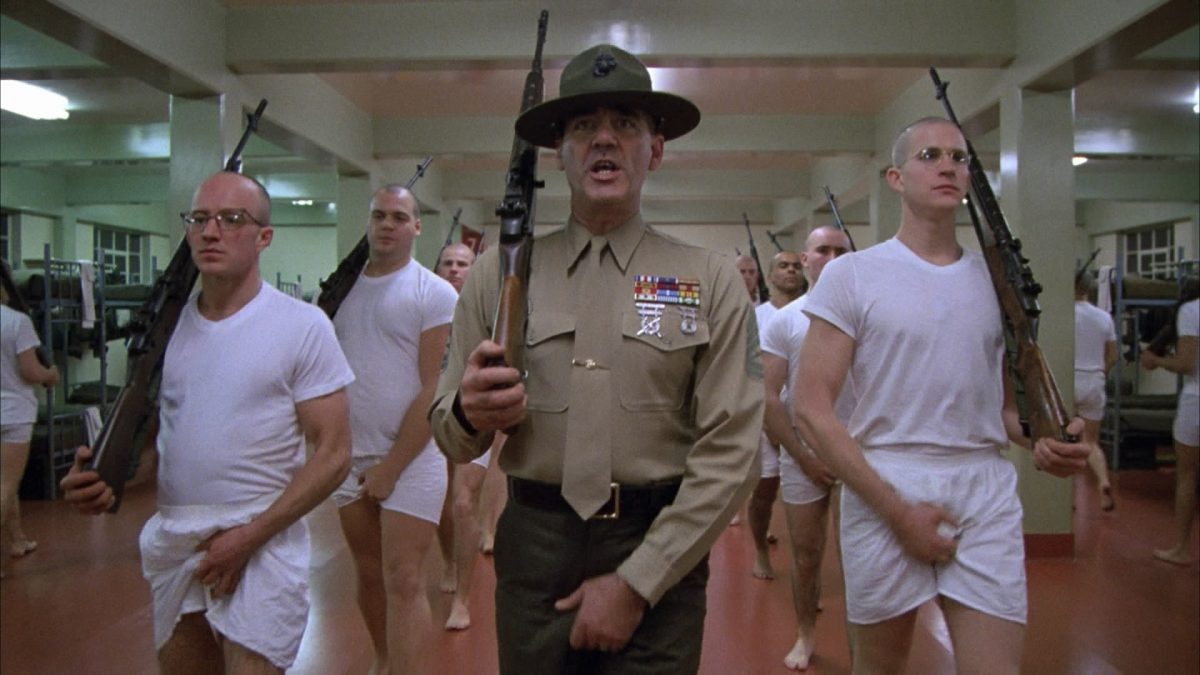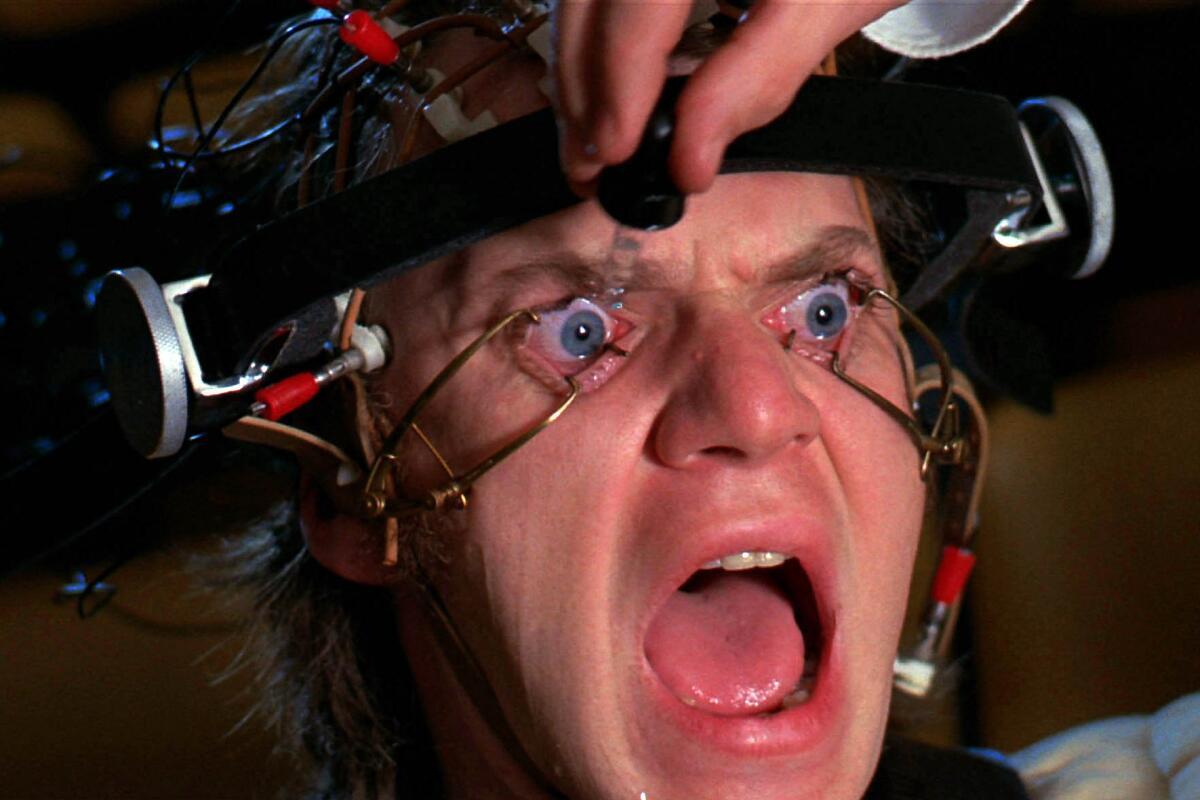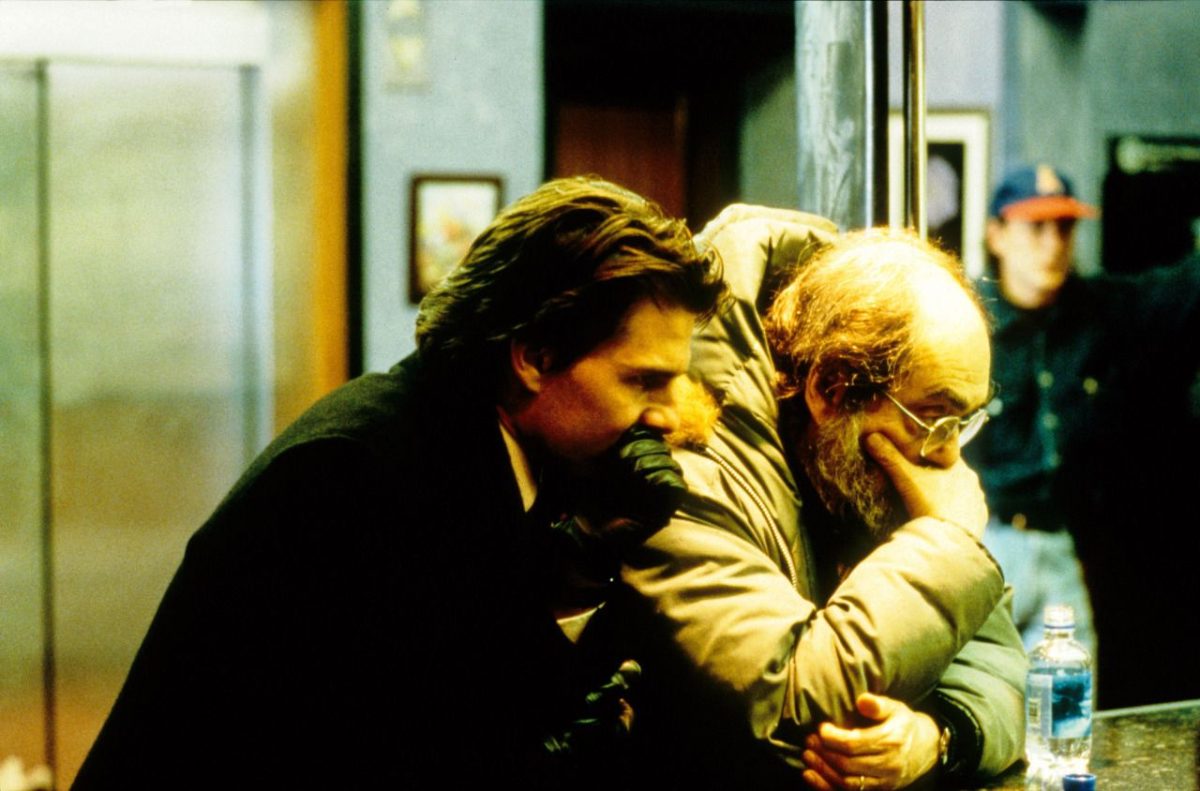Another Vietnam War Film Cycle
by Jack Boozer
One dark legacy of the nation that had still not been put to rest by this time was the Vietnam War, which is evident in Stanley Kubrick’s Full Metal Jacket and in the other notable combat film of the year, John Irvin’s Hamburger Hill. There were also two non-combat war film releases, Barry Levinson’s Good Morning, Vietnam and Francis Ford Coppola’s Gardens of Stone, which are not discussed here. These four films are all critical of the U.S. military presence in Vietnam, and hence constitute a basic thematic resurgence of the initial war film cycle that took place ten years earlier. They also reject the historically revisionist Vietnam War films from 1980 to 1986, which rely on macho, muscular super-hero stars, such as Sylvester Stallone and Chuck Norris, playing characters who blame the “over-cautious” and politicized military system back home for losing the war rather than the war policy itself.
This is far from the case in the ensemble combat films Full Metal Jacket and Hamburger Hill. The focal mission of each platoon or regiment is accomplished by the end, but only at a cost so great as to negate sense and meaning in the effort. American field officers as well as regular ground troops or pilots are sometimes shown to be their own worst enemies under the stresses of this particular war. The lack of clear battle lines in the usually random, spatially chaotic enemy engagements presented on screen brings the very notion of individual and group integrity and positioning into question. The potential 360-degree attack zone that often surrounds the visually impaired battle patrols on the ground introduces a new dimension of physical and mental breakdown. Booby trap wires may be at their feet, or Claymore mines may be hung in the trees for detonation by ground fire.
In the first half of Full Metal Jacket, marine recruits (“pukes”) are trained relentlessly day and night by their Parris Island drill instructor, Sgt. Hartman (R. Lee Emery). He demands that they be tough and hard, like the bullet heads referred to in the title. They are taught literally to embrace their weapons like lovers as they become hollowed out into killing machines for the corps. There is no privacy, escape, or useful rationale for these men once they are in the wartime military. If they can’t fit the killer’s mold, as the recruit nicknamed Gomer Pyle (Vince D’Onofrio) cannot, only the violence of his gun ironically becomes a way out when he reaches the breaking point. Notably sitting atop a john in the bunkhouse latrine in his underwear with live ammunition for his M-14, Pyle first shoots Sgt. Hartman, who once again has been screaming in his face, then turns the gun on himself and splatters his already useless brain in a bloody mess across the white tiles. This metaphorical punctuation mark on the film’s first half suggests that the casualties of war not only end up at home but begin at home through the process of military brainwashing, or by extension to the nation, through a single-minded policy reliance on military solutions.
The death of Sgt. Hartman and Pyle also occur right in front of Pyle’s fellow recruit who was assigned to help him, Private Joker (Matthew Modine). When the film’s second half opens in Vietnam, Joker has become a war correspondent with the military newspaper Stars and Stripes. His superior officer informs him that “this is not a particularly popular war in case you don’t know,” and that the newspaper publishes only two kinds of war news: stories of conversion of the Vietnamese enemy to the cause, or stories of exaggerated enemy “kills” that suggest combat victories. The military doesn’t tolerate mental ambiguity or analysis; hence Joker wants to be closer to the real action. When he gets his wished-for transfer to a combat platoon, he writes “Born to kill” on his helmet and carries a peace button on his jacket. This prompts a senior officer standing in front of a mass grave of lime-covered corpses to dress him down for confusion about the cause. “Don’t you love your country?… Then how about getting with the program? Why don’t you jump on the team and come in for the big win?” Later, when Joker’s unit is interviewed by a camera crew in the field, the soldier called Animal Mother (Adam Baldwin) responds to the notion of losing comrades for freedom by saying, “Died for freedom? Think we waste gooks for freedom? This is a slaughterhouse.” Another soldier comments at one point on the Vietnamese people: “We’re supposed to be helping them and all they do is shit on us.”
While earlier commentaries on this film tended toward humanitarian conclusions regarding the platoon’s coming-of-age redemption in war despite a troubled U.S. policy, more recent criticism has focused on the importance of a brutalized language and on self-negating contradictions among the characters in the film. These have been viewed as a key to its nihilism. The idea is that Kubrick’s movie, based loosely on Gustav Hasford’s novel The Short-Timers, sees this war as a fruitless disaster, a self-contradictory “mission impossible” that was all wrapped up in often random, desperate incidents void of an overarching story line with any meaning. Part of the problem for American troops in the real war was distinguishing the Viet Cong (V.C.) from friendly Vietnamese, since “friend-lies” by day could become “enemies” by night. A related example in the film is the helicopter door gunner who fires indiscriminately down upon Vietnamese farmers and their families. His rationale (addressed to Joker) is simply this: “Anyone who runs is V.C. Anyone who stands still is well-disciplined V.C.” There is no victory in this devastating war, only the glimmer of survival. The platoon’s extended confrontation with the sniper in the burning remains of the city of Hue builds to the film’s climax as three marines are shot down one by one. After the young female sniper is finally wounded and rendered harmless on the ground, Joker is left to finish the job with a shot to her head. There is relief but no sense of victory in this long sequence. Also, when what remains of the unit marches deliberately out of Hue, the singing of “The Mickey Mouse Club” theme song is entirely ironic. Vietnam is no Disneyland, and any real victory celebration is impossible. There is only a desperate camaraderie in arms and a longing for release from the battlefield and the military. This is the import of the closing shot as night falls and Joker’s final voiceover is heard, as if he has all along been reading from his war journals. He is thankful to be a survivor and going home. But can he, like America, really say goodbye to the war and the memories of death all around him, including the one recently at his feet who will live on in his dreams, however deserving of her last bullet?
The greatest irony in the narrative is gained not only through the constant presence of self-contradictory images within scenes as well as scene juxtapositions, but through the soldiers’ different responses to the news crews in the field. Joker was a cynical war correspondent in the beginning before he becomes an active combatant. Joker chooses the true reality of a warrior over the intentional misinformation of military news, but what he finds in battle is an even more invasive contravention of meaning. He explains sarcastically but flatly to his belligerent comrade Animal Mother: “I wanted to visit Vietnam, the crown jewel of Southeast Asia. I wanted to meet people of an exotic and interesting culture and kill them. I want to be the first person on my block to score a confirmed kill!” The platitudes of American promotional language are quickly inverted here. There are no principles; the battlefield is only about killing those on the other side and staying alive. The same conclusion can be drawn from the less sophisticated but thoroughly combat-driven Hamburger Hill. This film is a discourse on the meaning of futility based on a real ten-day campaign in the war, in which two-thirds of an American regiment were destroyed taking a hill that was simply abandoned a few weeks later. When a platoon sergeant is interviewed in the field about the squad’s failure to take the hill, he replies to the camera crew, “You really like this shit don’t you? It’s your job, the story. You’re waiting here like a fucking vulture, waiting for someone to die so you can take pictures. I’ve got more respect for the little bastards up there. At least they take a side. You just take pictures.”
Both films certify that Vietnam combat doesn’t make one a better person or necessarily get one closer to ideological insight about the war. The only problems that can get resolved in the heat of battle are the clashes of rank, race, and personality among the fighting men. Their personal frustrations can be directed against the threats to life and limb posed by the Viet Cong or North Vietnamese army regulars, who hold the facetiously nicknamed “Hamburger Hill” in Irvin’s film. The fighting unit has to be cohesive in mutual trust and support in order to be effective at all, whatever the larger policy issues surrounding the desired goals and outcomes of the military’s role. And this is exactly what does not happen, as a call for aerial help from the ground troops struggling up the hill brings in friendly helicopter gunships that rake and kill the U.S. forces by mistake. Moving by implication from the individual soldier’s extreme frustration in the field to the military’s goals, it is apparent that military hardness—the full metal jacket approach to foreign policy in Vietnam—created built-in failure from the outset. The military effort could not and did not win the hearts and minds of the Vietnamese people in great numbers because there was no local government ideology that the people sufficiently trusted or believed in as their own. Imported democracy through attempts at military-enforced stability did not work.
In Kubrick’s film, Joker’s evasive explanation to the colonel who questions him about the inscription on his helmet and his peace button implies much the same thing: “I think I was trying to suggest something about the duality of man, sir.” Again, the first half of Full Metal Jacket concerning the military brainwashing process of combat training already provides a powerful dramatic trope for the limitations of a monolithic, one-sided military that is expected to solve larger cultural problems of nation-states that it is in no way equipped to solve. The limitation of military solutions seems to be Joker’s particular lesson, which was also meant almost fifteen years after the end of hostilities for a nation that in Kubrick’s view had still not learned it.
This is far from the case in the ensemble combat films Full Metal Jacket and Hamburger Hill. The focal mission of each platoon or regiment is accomplished by the end, but only at a cost so great as to negate sense and meaning in the effort. American field officers as well as regular ground troops or pilots are sometimes shown to be their own worst enemies under the stresses of this particular war. The lack of clear battle lines in the usually random, spatially chaotic enemy engagements presented on screen brings the very notion of individual and group integrity and positioning into question. The potential 360-degree attack zone that often surrounds the visually impaired battle patrols on the ground introduces a new dimension of physical and mental breakdown. Booby trap wires may be at their feet, or Claymore mines may be hung in the trees for detonation by ground fire.
In the first half of Full Metal Jacket, marine recruits (“pukes”) are trained relentlessly day and night by their Parris Island drill instructor, Sgt. Hartman (R. Lee Emery). He demands that they be tough and hard, like the bullet heads referred to in the title. They are taught literally to embrace their weapons like lovers as they become hollowed out into killing machines for the corps. There is no privacy, escape, or useful rationale for these men once they are in the wartime military. If they can’t fit the killer’s mold, as the recruit nicknamed Gomer Pyle (Vince D’Onofrio) cannot, only the violence of his gun ironically becomes a way out when he reaches the breaking point. Notably sitting atop a john in the bunkhouse latrine in his underwear with live ammunition for his M-14, Pyle first shoots Sgt. Hartman, who once again has been screaming in his face, then turns the gun on himself and splatters his already useless brain in a bloody mess across the white tiles. This metaphorical punctuation mark on the film’s first half suggests that the casualties of war not only end up at home but begin at home through the process of military brainwashing, or by extension to the nation, through a single-minded policy reliance on military solutions.
The death of Sgt. Hartman and Pyle also occur right in front of Pyle’s fellow recruit who was assigned to help him, Private Joker (Matthew Modine). When the film’s second half opens in Vietnam, Joker has become a war correspondent with the military newspaper Stars and Stripes. His superior officer informs him that “this is not a particularly popular war in case you don’t know,” and that the newspaper publishes only two kinds of war news: stories of conversion of the Vietnamese enemy to the cause, or stories of exaggerated enemy “kills” that suggest combat victories. The military doesn’t tolerate mental ambiguity or analysis; hence Joker wants to be closer to the real action. When he gets his wished-for transfer to a combat platoon, he writes “Born to kill” on his helmet and carries a peace button on his jacket. This prompts a senior officer standing in front of a mass grave of lime-covered corpses to dress him down for confusion about the cause. “Don’t you love your country?… Then how about getting with the program? Why don’t you jump on the team and come in for the big win?” Later, when Joker’s unit is interviewed by a camera crew in the field, the soldier called Animal Mother (Adam Baldwin) responds to the notion of losing comrades for freedom by saying, “Died for freedom? Think we waste gooks for freedom? This is a slaughterhouse.” Another soldier comments at one point on the Vietnamese people: “We’re supposed to be helping them and all they do is shit on us.”
While earlier commentaries on this film tended toward humanitarian conclusions regarding the platoon’s coming-of-age redemption in war despite a troubled U.S. policy, more recent criticism has focused on the importance of a brutalized language and on self-negating contradictions among the characters in the film. These have been viewed as a key to its nihilism. The idea is that Kubrick’s movie, based loosely on Gustav Hasford’s novel The Short-Timers, sees this war as a fruitless disaster, a self-contradictory “mission impossible” that was all wrapped up in often random, desperate incidents void of an overarching story line with any meaning. Part of the problem for American troops in the real war was distinguishing the Viet Cong (V.C.) from friendly Vietnamese, since “friend-lies” by day could become “enemies” by night. A related example in the film is the helicopter door gunner who fires indiscriminately down upon Vietnamese farmers and their families. His rationale (addressed to Joker) is simply this: “Anyone who runs is V.C. Anyone who stands still is well-disciplined V.C.” There is no victory in this devastating war, only the glimmer of survival. The platoon’s extended confrontation with the sniper in the burning remains of the city of Hue builds to the film’s climax as three marines are shot down one by one. After the young female sniper is finally wounded and rendered harmless on the ground, Joker is left to finish the job with a shot to her head. There is relief but no sense of victory in this long sequence. Also, when what remains of the unit marches deliberately out of Hue, the singing of “The Mickey Mouse Club” theme song is entirely ironic. Vietnam is no Disneyland, and any real victory celebration is impossible. There is only a desperate camaraderie in arms and a longing for release from the battlefield and the military. This is the import of the closing shot as night falls and Joker’s final voiceover is heard, as if he has all along been reading from his war journals. He is thankful to be a survivor and going home. But can he, like America, really say goodbye to the war and the memories of death all around him, including the one recently at his feet who will live on in his dreams, however deserving of her last bullet?
The greatest irony in the narrative is gained not only through the constant presence of self-contradictory images within scenes as well as scene juxtapositions, but through the soldiers’ different responses to the news crews in the field. Joker was a cynical war correspondent in the beginning before he becomes an active combatant. Joker chooses the true reality of a warrior over the intentional misinformation of military news, but what he finds in battle is an even more invasive contravention of meaning. He explains sarcastically but flatly to his belligerent comrade Animal Mother: “I wanted to visit Vietnam, the crown jewel of Southeast Asia. I wanted to meet people of an exotic and interesting culture and kill them. I want to be the first person on my block to score a confirmed kill!” The platitudes of American promotional language are quickly inverted here. There are no principles; the battlefield is only about killing those on the other side and staying alive. The same conclusion can be drawn from the less sophisticated but thoroughly combat-driven Hamburger Hill. This film is a discourse on the meaning of futility based on a real ten-day campaign in the war, in which two-thirds of an American regiment were destroyed taking a hill that was simply abandoned a few weeks later. When a platoon sergeant is interviewed in the field about the squad’s failure to take the hill, he replies to the camera crew, “You really like this shit don’t you? It’s your job, the story. You’re waiting here like a fucking vulture, waiting for someone to die so you can take pictures. I’ve got more respect for the little bastards up there. At least they take a side. You just take pictures.”
Both films certify that Vietnam combat doesn’t make one a better person or necessarily get one closer to ideological insight about the war. The only problems that can get resolved in the heat of battle are the clashes of rank, race, and personality among the fighting men. Their personal frustrations can be directed against the threats to life and limb posed by the Viet Cong or North Vietnamese army regulars, who hold the facetiously nicknamed “Hamburger Hill” in Irvin’s film. The fighting unit has to be cohesive in mutual trust and support in order to be effective at all, whatever the larger policy issues surrounding the desired goals and outcomes of the military’s role. And this is exactly what does not happen, as a call for aerial help from the ground troops struggling up the hill brings in friendly helicopter gunships that rake and kill the U.S. forces by mistake. Moving by implication from the individual soldier’s extreme frustration in the field to the military’s goals, it is apparent that military hardness—the full metal jacket approach to foreign policy in Vietnam—created built-in failure from the outset. The military effort could not and did not win the hearts and minds of the Vietnamese people in great numbers because there was no local government ideology that the people sufficiently trusted or believed in as their own. Imported democracy through attempts at military-enforced stability did not work.
In Kubrick’s film, Joker’s evasive explanation to the colonel who questions him about the inscription on his helmet and his peace button implies much the same thing: “I think I was trying to suggest something about the duality of man, sir.” Again, the first half of Full Metal Jacket concerning the military brainwashing process of combat training already provides a powerful dramatic trope for the limitations of a monolithic, one-sided military that is expected to solve larger cultural problems of nation-states that it is in no way equipped to solve. The limitation of military solutions seems to be Joker’s particular lesson, which was also meant almost fifteen years after the end of hostilities for a nation that in Kubrick’s view had still not learned it.
Stephen Prince (Edited by), American Cinema of the 1980s – Themes and Variations (2007), , pp. 179-183




